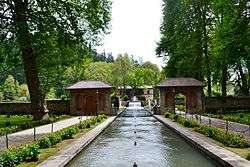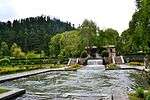Achabal Gardens
 Location in Jammu and Kashmir  Location in Jammu and Kashmir | |
| Location | Achabal, Anantnag district, India |
|---|---|
| Region | Asia |
| Coordinates | 33°40′59″N 75°13′20″E / 33.6831°N 75.2222°ECoordinates: 33°40′59″N 75°13′20″E / 33.6831°N 75.2222°E |
| Type | Mughal Gardens |
| Length | 467 feet (142 m) |
| Width | 45 feet (14 m) |
| Area | 21,015 square feet (1,952.4 m2) |
| History | |
| Builder | Nur Jahan |
| Founded | 1620 A.D. |
| Cultures | Mughal Empire |
| Site notes | |
| Condition | Rebuilt |
| Public access | Public garden |
Achabal Garden is one of the most important and splendid tourist places in the state of Kashmir and is about 8 kilometers away from Anantnag. It was in the state of Kashmir that the Mughal style gardens was brought to perfection and Achabal is one such masterpiece. This place is famous all over due to an ancient spring surrounded by a terrace garden, which was developed by Mughals. The historical significance of this place strikes the visitor with awe.Achabal Garden, once the pleasure retreat of the Mughal Empress Noor Jahan is a beautifully created garden in Kashmir with its own special allure and character. Its picturesque beauty makes it one of the best Mughal gardens of the Indian subcontinent. It is difficult to describe in words the mesmerizing beauty of this Mughal style garden. The upper portion of the garden is popularly known as `Bag-e-Begum Abad` and was developed by Malika Noor Jehan Begum in 1620 A.D. Later it became renowned as Sahib Abad in which there was a `Hamam` or treasure of water getting heat from a logical lamp or `tosng`. The garden was created at the site of a powerful spring, which enters the garden as a waterfall. The design of this wonderfully created garden is ascribed to the beloved wife of the Mughal Emperor Jahangir. The Garden of Achabal is located at the foot of a hill covered with dense forest, which is 8 kilometers from Anantnag and 56 kilometers from Srinagar. The daughter of the Mughal monarch Shah Jahan built the garden in the year 1620 with cascading outpourings and pavilions. The most beautiful of all springs is Achabal and it gushes out of the Sosanwar Hill. In the garden of Achabal the water gushes out of the spasm with great vigor throughout the entire year. In the later ages the Mughal prince Dara Shikoh built a mosque in the garden. There is also a trout farm for seed fish nearby. There are tourist bungalows and tourist huts nearby where the tourists can spend some moments in the lap of the beautiful setup. This garden is universally regarded as a visual treat for the eyes. This garden is also well adorned with sprawling Chinar trees. Stepped terraces, ornamental shrubs and conventional elegance, are the added attraction, which not only mesmerizes one but also attracts thousands of tourists from all over the globe every year. Accommodation is available at the nearby tourist bungalows or rest houses. Achabal not only serves as a breathtaking splendor but also is a reviving experience for all tourists. Achabal Gardens, "the places of the princes", is a small Mughal garden located at the southeastern end of the Kashmir Valley in the town of Achabal, Anantnag district, India. Located near the Himalayan Mountains, the site may have been a Hindu sacred site known as "Akkshavala" previously.[1]
Overview
It was built about 1620 A.D. by Mughal Empire Emperor Jahangir's wife, Nur Jahan, called the "greatest garden lovers of them all." The garden was rebuilt on smaller scale by Gulab Singh and is now a public garden.[1] A main feature of the garden is a waterfall that enters into a pool of water.[2]
This place is also noted for its spring, which is finest in Kashmir and is supposed to be the re-appearance of a portion of the river Bringhi, whose waters suddenly disappear through a large fissure underneath a hill at the village Wani Divalgam in the Brang Pargana. It is said that in order to test this, a quantity of chaff was thrown in the Bringhi river at a place its water disappears at Wani Divalgam and that chaff came out of the Achabal spring. The water of the spring issues from several places near the foot of a low spur which is densely covered with deodar trees and at one place it gushes out from an oblique fissure large enough to admit a man's body and forms a volume some 18 inches high and about a foot in diameter.[3]
Business
- Time 2 Taste Restaurant
- Mughal View Restaurant
- Raja Hotel
- Zaiqa Restaurant
- Amir Telecom
Gallery
References
- 1 2 Achabal Gardens. Archived December 23, 2012, at the Wayback Machine. Archnet.org. Retrieved 2012-01-17.
- ↑ Achabal Gardens. GardenVisit. 2008. Retrieved 2012-01-17.
- ↑ Koul, Pandit Anand: Archaeological Remains in Kashmir page 94. Mercantile press, 1935.
Further reading
- Brookes, John. (1987). Gardens of Paradise: History and Design of the Great Islamic Gardens. London: Weidenfeld and Nicholson.
- Crowe, Sylvia; Haywood, S.; Jellicoe, S.; Patterson, G. (1972). The Gardens of Mughal India. London: Thames and Hudson.
- Petruccioli, Attilio. "Gardens and Religious Topography in Kashmir." Environmental Design. 1-2 (1991):64-73.

